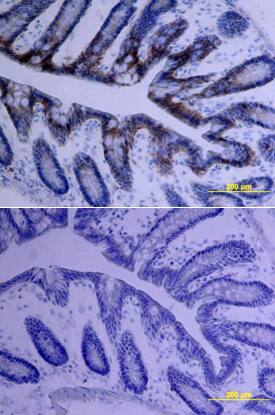Mouse HAI-1 Biotinylated Antibody
R&D Systems, part of Bio-Techne | Catalog # BAF1141


Key Product Details
Species Reactivity
Validated:
Cited:
Applications
Validated:
Cited:
Label
Antibody Source
Product Specifications
Immunogen
Specificity
Clonality
Host
Isotype
Scientific Data Images for Mouse HAI-1 Biotinylated Antibody
HAI‑1 in Mouse Intestine.
HAI-1 was detected in perfusion fixed frozen sections of mouse intestine using Goat Anti-Mouse HAI-1 Biotinylated Antigen Affinity-purified Polyclonal Antibody (Catalog # BAF1141) at 15 µg/mL overnight at 4 °C. Tissue was stained using the Anti-Goat HRP-DAB Cell & Tissue Staining Kit (brown; Catalog # CTS008) and counterstained with hematoxylin (blue). Lower panel shows a lack of labeling if primary antibodies are omitted and tissue is stained only with secondary antibody followed by incubation with detection reagents. View our protocol for Chromogenic IHC Staining of Frozen Tissue Sections.Applications for Mouse HAI-1 Biotinylated Antibody
Immunohistochemistry
Sample: Perfusion fixed frozen sections of mouse intestine
Western Blot
Sample: Recombinant Mouse HAI-1 (Catalog # 1141-PI)
Mouse HAI-1 Sandwich Immunoassay
Formulation, Preparation, and Storage
Purification
Reconstitution
Formulation
Shipping
Stability & Storage
- 12 months from date of receipt, -20 to -70 °C as supplied.
- 1 month, 2 to 8 °C under sterile conditions after reconstitution.
- 6 months, -20 to -70 °C under sterile conditions after reconstitution.
Background: HAI-1
Hepatocyte growth factor activator inhibitor-1 (HAI-1) encoded by the Spint1 gene is a Kunitz-type serine protease inhibitor, identified as a strong inhibitor of HGF activator (HGFA) and matripase (1). The membrane-anchored HAI-1 consists of two Kunitz domains, a LDL-receptor-like domain, and a C-terminal transmembrane domain (2). Two soluble forms are generated by ectodomain shedding, one with a single Kunitz domain and the other with two Kunitz domains. HAI-1 is not only an inhibitor but also a specific receptor of active HGFA, acting as a reservoir of this enzyme on the cell surface (3). The shedding of HAI-1 and HGFA/HAI-1 complex is enhanced by treatment with phorbol 12-myristate, 13-acetate or IL-1 beta. The regulated shedding is completely inhibited by a synthetic zinc metalloprotease inhibitor (3).
References
- Denda, et al. (2002) J. Biol. Chem. 277:14053.
- Shimomura, et al. (1997) J. Biol. Chem. 272:6370.
- Kataoka, et al. (2000) J. Biol. Chem. 275:40453.
Long Name
Alternate Names
Gene Symbol
Additional HAI-1 Products
Product Documents for Mouse HAI-1 Biotinylated Antibody
Product Specific Notices for Mouse HAI-1 Biotinylated Antibody
For research use only